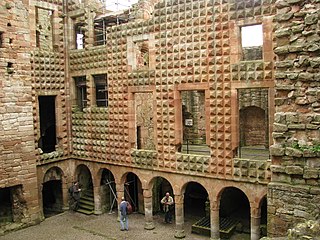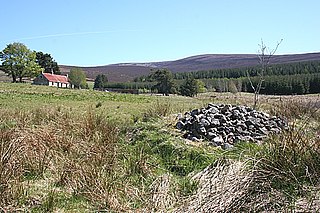Related Research Articles

John Maitland, 1st Lord Maitland of Thirlestane, of Lethington, Knight (1581), was Lord Chancellor of Scotland.
Michael Balfour, 1st Lord Balfour of Burleigh PC was a Scottish peer.

Francis Stewart, 5th Earl of Bothwell was Commendator of Kelso Abbey and Coldingham Priory, a Privy Counsellor and Lord High Admiral of Scotland. He was a notorious conspirator, who led several uprisings against King James VI and died in poverty, in Italy, after being banished from Scotland. Francis was the first cousin of King James VI of Scotland. Francis's maternal uncle James Hepburn, 4th Earl of Bothwell was the chief suspect in the murder of James VI's father Henry Stuart, Lord Darnley.
Sir William Stewart of Houston was a Scottish soldier, politician and diplomat.
Sir Thomas Lyon, Master of Glamis was a Scottish nobleman and official, Lord High Treasurer of Scotland.

Alexander Lindsay, 1st Lord Spynie was a Scottish nobleman. His death is the subject of the ballad Lord Spynie.

John Wemyss younger of Logie, (1569-1596), was a Scottish courtier, spy, and subject of the ballad "The Laird o Logie", beheaded for plotting to blow up a fortification at Veere in the Netherlands
Henry Lindsay, 13th Earl of Crawford also known as Harry Charteris, was a Scottish landowner and courtier.

Margaret Vinstarr, was a Danish or German courtier in Scotland to Anne of Denmark commemorated by the ballad "The Laird o Logie" for rescuing her imprisoned lover.

Henrietta Stewart (1573–1642) was a Scottish courtier. She was the influential favourite of the queen of Scotland, Anne of Denmark.
Margaret Stewart, Mistress of Ochiltree was a courtier in the household of Anne of Denmark in Scotland and looked after her children Prince Henry, Princess Elizabeth, and Charles I of England
Sir James Sandilands was a courtier to King James VI and I and captain of Blackness Castle
Alexander Home of North Berwick was a Scottish landowner and Provost of Edinburgh.
Jean Lyon, Countess of Angus was a Scottish courtier, landowner, who became involved in a withcraft trial.
Margaret Douglas, Countess of Bothwell was a Scottish aristocrat and courtier.
Archibald Wauchope of Niddrie Scottish landowner and rebel.

Patrick Gordon of Auchindoun (1538–1594) was a Scottish landowner and rebel.

James Douglas of Spott was a Scottish landowner and conspirator.

The Raid of Holyrood was an attack on Holyrood Palace, Edinburgh on 27 December 1591 by Francis Stewart, 5th Earl of Bothwell in order to gain the favour of King James VI of Scotland. Bothwell subsequently staged a raid at Falkland Palace, and in July 1593 made another attempt at Holyrood.
William Stewart of Caverston and Traquair, was a Scottish landowner and Captain of Dumbarton Castle.
References
- ↑ HMC Mar & Kellie, vol. 1 (London, 1904), p. 18.
- ↑ Calendar State Papers Scotland, vol. 9 (Edinburgh, 1916), p. 577.
- ↑ David Masson, Register of the Privy Council of Scotland: 1585-1592, vol. 4 (Edinburgh, 1881), pp. 625, 642, 807.
- ↑ Calendar State Papers Scotland, vol. 10 (Edinburgh, 1936), pp. 650, 687, 818, 821.
- ↑ Annie Isabella Cameron, Calendar State Papers Scotland, vol. 11 (Edinburgh, 1936), p. 305 no. 238.
- ↑ Calendar State Papers Scotland, vol. 11 (Edinburgh, 1936), pp. 395 no. 307, 536 no. 472.
- ↑ David Masson, Register of the Privy Council of Scotland: 1592-1599, vol. 6 (Edinburgh, 1882), p. 114., Spynie, Wauchope, and Pennycuke were denounced on 27 December 1594.
- ↑ Michael Pearce, 'Anna of Denmark: Fashioning a Danish Court in Scotland', The Court Historian, 24:2 (2019) pp. 146-8.
- ↑ Calendar State Papers Scotland, vol. 11 (Edinburgh, 1936), pp. 530-1 & fn, 534, 536.
- ↑ David Masson, Register of the Privy Council of Scotland: 1592-1599, vol. 6 (Edinburgh, 1882), p. 207.
- ↑ Calendar State Papers Scotland, vol. 11 (Edinburgh, 1936), pp. 536 no. 472, 538 no. 474.
- ↑ Winifred Coutts, The Business of the College of Justice in 1600 (Edinburgh: Stair Society, 2003), p. 514.
- ↑ Winifred Coutts, he Business of the College of Justice in 1600 (Edinburgh: Stair Society, 2003), p. 517.
- ↑ David Masson, Register of the Privy Council of Scotland: 1619-1622, vol. 12 (Edinburgh, 1895), pp. 207-8, 209: Original Letters Relating to the Ecclesiastical Affairs of Scotland: 1614-1625, vol. 2 (Edinburgh, 1851), pp. 602-5.